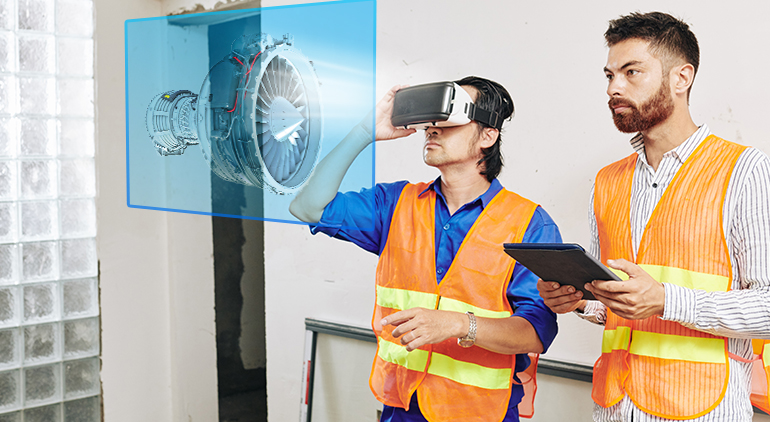AME (Aircraft Maintenance Engineering) Training Through VR

A fully functional virtual flight deck and a virtual aircraft is all that is needed for a maintenance technician to train. They can experiment with equipment bays and even remove and install components to see the results in real time.
This greatly reduces cost and improves overall operational efficiency. Before familiarizing with the other benefits, let us take a look at where the market stays at the moment
PWC has calculated a 47% application of virtual reality for maintenance training across industries.
According to Research and Markets, the VR powered Maintenance and Repair is expected to reach $3319 Million by 2024 from $403.3 Million in 2018. The market is also expected to exhibit a CAGR of 42.1% from 2018 to 2024.
The market looks promising and the adoption is already underway. Applications include virtual maintenance trainers that present 3D training scenarios to students. Basic training of aviation mechanics is further simplified through VR headsets.
Complex tasks that may be too expensive or impractical to be created in real-life such as high noise levels or a certain level of in-flight chaos can be easily projected through virtual reality in education technology.
This arms the students with better real-life, high-risk situational knowledge. The benefits are plenty. Let us take a deep dive into some other advantages.
Benefits Of VR-Powered AME: Some Use Cases
1) Engineering and Mechanics
MRO Network predicts that the number of civil aviation passengers will double by the year 2036. The aviation industry requires more trained engineers to maintain the growing machine fleet.
This has boosted the aviation maintenance training market to reach a CAGR of 7% from 2020 to 2023. This means an increased number of institutions providing the education.
This also means that not every student will get a chance to experience the nuances of AME due to a lack of infrastructure.
Virtual reality can help. Through VR, the institutions can bridge the gap and get all the students to have a lot of training time making them proficient is complex structures like jet engines and turboprops.
 Get the App from Meta Store: Download Now
Get the App from Meta Store: Download Now
2) Ground Staff Training
On-the-job training is the current modus operandi for ground staff training. This personnel is responsible for the intricate inspection of aircraft parts before departure.
IATA has recommended VR training for the staff, effectively making them much more reliable for on the spot maintenance and minor fixes.
3) De-Icing and Anti-Icing
Crew members are required to spray liquid chemicals in specific quantities to de-ice a body part or for the anti-icing of the machine during flight. This requires precision and speed.
The operation is carried out very close to the flight departure, making accuracy a prime factor. Inexperienced members often spray faulty quantities, leading to a huge loss for the maintenance team.
Through VR training, airports in Lithuania and Poland are offering the crew members enough practice and training time for de-icing, effectively increasing the efficiency and minimizing unwanted losses.
These use cases prove the lubrication that VR can bring to aircraft maintenance virtual reality in engineering. Both on-job and academic lenses have been covered.
So who are the leading companies currently employing VR as an effective training tool? Let us take a look at some industry players who are leading the pack in terms of adoption.
"Harness the power of VR to master aircraft maintenance skills with iXR Labs' innovative training module, where learning meets cutting-edge technology"
Example Of VR In Aircraft Maintenance Training
Boeing
Boeing is experimenting with XRLF or Extended Reality Learning Framework. It is a virtual maintenance training initiative which is a cloud based solution for AME training.
Airbus A400M Atlas
A400M is training its crew members using a CAE powered virtual maintenance trainer to reduce the use of dedicated aircrafts for training.
Udc
University of DC Community College has an aviation program that uses L3Harris 737-800 model of VR maintenance training. This is helpful for students to understand hydraulics and landing gear along with faulty avionics and other failures in a safe environment.
Ge Aviation
GE Aviation is integrating a training tech upgrade for it Customer Technical Education Center with a learning management system armed with their own virtual maintenance trainer.
Magpie
Magpie is a student performance tracker developed by Charles River Analytics in collaboration with DiSTI. It monitors student behavior, involvement, and level of understanding in a real-time, simulated environment.
Tstc
Texas State Technical College is using flight simulation software to imbibe the knowledge of a 737-800 startup sequence among students.
The adoptions look plenty. The benefits look healthy. The alternative looks attractive. What can we conclude from this discussion about virtual reality powered aircraft maintenance engineering training?
Conclusion
Competent engineers mean safer flights.
The major drivers to the widespread adoption of VR for AME will be
Increased outsourcing of maintenance.
Safety standard compliance.
Innovation in aircraft components.
Industry leaders such as CAE, AAR, Honeywell International, Flightpath International, and Global Jet Services have already started investing into the digitization of aircraft VR maintenance training.
When we look at it from an academic lens, University of DC, Texas State College, and Wichita State University among others have integrated the tech to their academic provisions.
At iXR Labs, we unearth technological innovations virtual reality in education india. To learn more about our cutting edge tech, visit us at iXR Labs .




